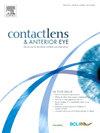Optimising the methodology for assessing tear meniscus height using digital imaging
IF 3.7
3区 医学
Q1 OPHTHALMOLOGY
引用次数: 0
Abstract
Purpose
To determine the optimum method for assessing tear meniscus height using digital imaging.
Method
The tear meniscus of 38 participants (mean age 32.5 ± 10.6 years, 45 % male) was video recorded three times, each for a period of five seconds following two natural blinks using the Oculus Keratograph 5M, first with infrared and subsequently with visible (white) light. Still images at 0.5 s intervals from the last blink, up to 5 s, were extracted from the video recording and the lower eyelid tear meniscus height was measured using ImageJ at seven locations; immediately below pupil centre and at 1 mm, 3 mm and 6 mm, nasally and temporally. Dryness symptoms were assessed with the Ocular Surface Disease Index (OSDI) and tear film stability with non-invasive tear breakup time with the Oculus Keratograph 5M.
Results
A significant difference in the tear meniscus height was measured with infrared (0.29 ± 0.08 mm) compared to white light (0.27 ± 0.08 mm; p < 0.001). Tear meniscus height increased significantly with repeated measurement (first: 0.27 ± 0.08 mm; second 0.27 ± 0.08; 0.28 ± 0.09; p = 0.005). In each case, following a significant decrease immediately after a blink, the tear meniscus height was stable between 1.0 and 2.5 s and increased thereafter (p < 0.001). A consistent tear meniscus height measurement was achieved by measuring within 1 mm of the pupil midline, but increased more peripherally (p < 0.001). Differences in height, while statistically significant, were not clinically significant except in the peripheral measurements.
Conclusion
Tear meniscus height should be measured in a consistent manner, either with infrared or white light. A single measurement from the top of the meniscus to the eyelid margin within 1 mm of the pupil midline, from an image captured 1.0 to 2.5 s after two blinks, is sufficient.
利用数码成像技术优化评估撕裂半月板高度的方法。
目的:探讨利用数字成像技术评估撕裂半月板高度的最佳方法。方法:对38名参与者(平均年龄32.5±10.6岁,男性45%)的撕裂半月板进行3次视频记录,每次5秒,在两次自然眨眼后,使用5M眼眼角膜摄影仪,先用红外光,后用可见光(白光)拍摄。从录像中提取最后一次眨眼间隔0.5 s,最长5 s的静止图像,使用ImageJ在7个位置测量下眼睑撕裂半月板高度;紧接瞳孔中心下方,在鼻部和颞部1mm, 3mm和6mm处。用眼表疾病指数(OSDI)和泪膜稳定性(无创泪液破裂时间)评估干燥症状。结果:红外光测量撕裂半月板高度(0.29±0.08 mm)与白光测量撕裂半月板高度(0.27±0.08 mm)差异有统计学意义;结论:撕裂半月板高度测量应采用一致的方法,采用红外光或白光测量。从半月板顶部到距瞳孔中线1毫米以内的眼睑边缘,从两次眨眼后1.0到2.5秒的图像中进行一次测量就足够了。
本文章由计算机程序翻译,如有差异,请以英文原文为准。
求助全文
约1分钟内获得全文
求助全文
来源期刊

Contact Lens & Anterior Eye
OPHTHALMOLOGY-
CiteScore
7.60
自引率
18.80%
发文量
198
审稿时长
55 days
期刊介绍:
Contact Lens & Anterior Eye is a research-based journal covering all aspects of contact lens theory and practice, including original articles on invention and innovations, as well as the regular features of: Case Reports; Literary Reviews; Editorials; Instrumentation and Techniques and Dates of Professional Meetings.
 求助内容:
求助内容: 应助结果提醒方式:
应助结果提醒方式:


